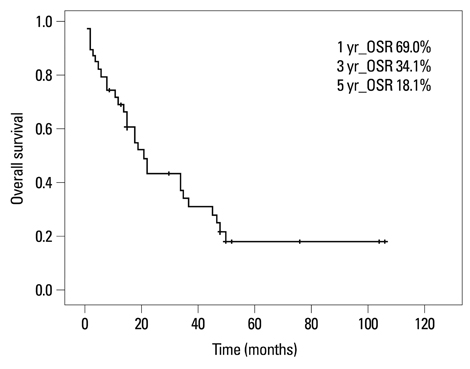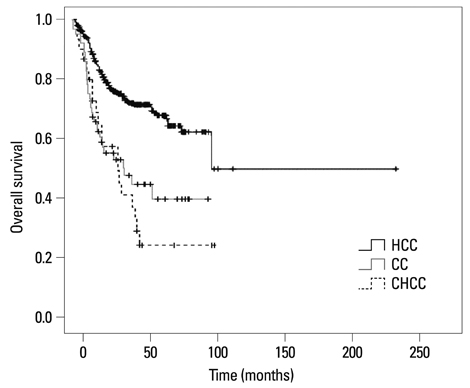Yonsei Med J.
2011 Sep;52(5):753-760. 10.3349/ymj.2011.52.5.753.
Clinicopathological Characteristics in Combined Hepatocellular-Cholangiocarcinoma: A Single Center Study in Korea
- Affiliations
-
- 1Department of Internal Medicine, Yonsei University College of Medicine, Seoul, Korea. drpjy@yuhs.ac
- 2Department of Surgery, Yonsei University College of Medicine, Seoul, Korea.
- 3Liver Cancer Special Clinic, Yonsei University College of Medicine, Seoul, Korea.
- 4Department of Surgery, Korea University College of Medicine, Seoul, Korea.
- 5Liver Cirrhosis Clinical Research Center, Seoul, Korea.
- 6Brain Korea 21 Project Medical Science, Seoul, Korea.
- KMID: 1108067
- DOI: http://doi.org/10.3349/ymj.2011.52.5.753
Abstract
- PURPOSE
Combined hepatocellular-cholangiocarcinoma (CHCC) is an uncommon form of cancer, and its clinicopathological features have rarely been reported in detail. This study was undertaken to evaluate the clinicopathological characteristics and prognostic factors of CHCC.
MATERIALS AND METHODS
The clinicopathological features of patients diagnosed with CHCC at Severance Hospital between January 1996 and December 2007 were retrospectively studied by comparing them with the features of patients with hepatocellular carcinoma (HCC) or cholangiocarcinoma (CC) who had undergone a hepatic resection during the same period.
RESULTS
Forty-three patients diagnosed with CHCC were included in this study (M : F=35 : 8, median age, 55 years). According to the parameters of the American Joint Committee on Cancer staging, there were 6 (14.0%), 9 (20.9%), 25 (58.1%), and 3 (7.0%) patients with stages I, II, III, and IV cancer, respectively. Thirty-two of the 43 patients underwent resection with curative intent. After resection, 27 patients (84.4%) had tumor recurrence during the follow-up period of 18 months (range: 6-106 months), and the median time to recurrence was 13 months. Overall median survival periods after hepatic resection of CHCC, HCC and CC were 34, 103 and 38.9 months, respectively (p<0.001). The median overall survival for all patients with CHCC was 21 months, and the 5-year survival rate was 18.1%. The presence of portal vein thrombosis and distant metastasis were independent prognostic factors of poor survival.
CONCLUSION
Even after curative hepatic resection, the presence of a cholangiocellular component appeared to be a poor prognostic indicator in patients with primary liver cancer.
Keyword
MeSH Terms
Figure
Cited by 2 articles
-
Adrenal metastasis in sequentially developed combined hepatocellular carcinoma-cholangiocarcinoma: A case report
Adianto Nugroho, Kwang-Woong Lee, Kyung-Bun Lee, Hyo-Shin Kim, Hyeyoung Kim, Nam-Joon Yi, Kyung-Suk Suh
Ann Hepatobiliary Pancreat Surg. 2018;22(3):287-291. doi: 10.14701/ahbps.2018.22.3.287.Clinicopathological characteristics and prognostic factors in combined hepatocellular carcinoma and cholangiocarcinoma
Sang Eun Park, Sung Ha Lee, Jae Do Yang, Hong Pil Hwang, Si Eun Hwang, Hee Chul Yu, Woo Sung Moon, Baik Hwan Cho
Korean J Hepatobiliary Pancreat Surg. 2013;17(4):152-156. doi: 10.14701/kjhbps.2013.17.4.152.
Reference
-
1. Koh KC, Lee H, Choi MS, Lee JH, Paik SW, Yoo BC, et al. Clinicopathologic features and prognosis of combined hepatocellular cholangiocarcinoma. Am J Surg. 2005. 189:120–125.
Article2. Maeda T, Adachi E, Kajiyama K, Sugimachi K, Tsuneyoshi M. Combined hepatocellular and cholangiocarcinoma: proposed criteria according to cytokeratin expression and analysis of clinicopathologic features. Hum Pathol. 1995. 26:956–964.
Article3. Taguchi J, Nakashima O, Tanaka M, Hisaka T, Takazawa T, Kojiro M. A clinicopathological study on combined hepatocellular and cholangiocarcinoma. J Gastroenterol Hepatol. 1996. 11:758–764.
Article4. Gibson JB, Sobin LH. Histological typing of tumours of the liver, biliary tract, and pancreas. 1978. Geneva: World Health Organization.5. Ishak KG, Anthony PP, Sobin LH. Histological typing of tumors of the liver. 1994. 2nd ed. Berlin: Springer.6. ALLEN RA, LISA JR. Combined liver cell and bile duct carcinoma. Am J Pathol. 1949. 25:647–655.7. Choi SB, Kim KS, Choi JY, Park SW, Choi JS, Lee WJ, et al. The prognosis and survival outcome of intrahepatic cholangiocarcinoma following surgical resection: association of lymph node metastasis and lymph node dissection with survival. Ann Surg Oncol. 2009. 16:3048–3056.
Article8. Jarnagin WR, Weber S, Tickoo SK, Koea JB, Obiekwe S, Fong Y, et al. Combined hepatocellular and cholangiocarcinoma: demographic, clinical, and prognostic factors. Cancer. 2002. 94:2040–2046.9. Honda H, Onitsuka H, Yasumori K, Hayashi T, Ochiai K, Gibo M, et al. Intrahepatic peripheral cholangiocarcinoma: two-phased dynamic incremental CT and pathologic correlation. J Comput Assist Tomogr. 1993. 17:397–402.10. Honda H, Ochiai K, Adachi E, Yasumori K, Hayashi T, Kawashima A, et al. Hepatocellular carcinoma: correlation of CT, angiographic, and histopathologic findings. Radiology. 1993. 189:857–862.
Article11. Goodman ZD, Ishak KG, Langloss JM, Sesterhenn IA, Rabin L. Combined hepatocellular-cholangiocarcinoma. A histologic and immunohistochemical study. Cancer. 1985. 55:124–135.
Article12. Liu CL, Fan ST, Lo CM, Ng IO, Lam CM, Poon RT, et al. Hepatic resection for combined hepatocellular and cholangiocarcinoma. Arch Surg. 2003. 138:86–90.
Article13. Ng IO, Shek TW, Nicholls J, Ma LT. Combined hepatocellular-cholangiocarcinoma: a clinicopathological study. J Gastroenterol Hepatol. 1998. 13:34–40.
Article14. Yano Y, Yamamoto J, Kosuge T, Sakamoto Y, Yamasaki S, Shimada K, et al. Combined hepatocellular and cholangiocarcinoma: a clinicopathologic study of 26 resected cases. Jpn J Clin Oncol. 2003. 33:283–287.
Article15. Lin G, Toh CH, Wu RC, Ko SF, Ng SH, Chou WC, et al. Combined hepatocellular cholangiocarcinoma: prognostic factors investigated by computed tomography/magnetic resonance imaging. Int J Clin Pract. 2008. 62:1199–1205.
Article16. Bhagat V, Javle M, Yu J, Agrawal A, Gibbs JF, Kuvshinoff B, et al. Combined hepatocholangiocarcinoma: case-series and review of literature. Int J Gastrointest Cancer. 2006. 37:27–34.
Article17. Kim H, Park MS, Park YN, Kim H, Kim KS, Choi JS, et al. Preoperative radiologic and postoperative pathologic risk factors for early intra-hepatic recurrence in hepatocellular carcinoma patients who underwent curative resection. Yonsei Med J. 2009. 50:789–795.
Article18. Chantajitr S, Wilasrusmee C, Lertsitichai P, Phromsopha N. Combined hepatocellular and cholangiocarcinoma: clinical features and prognostic study in a Thai population. J Hepatobiliary Pancreat Surg. 2006. 13:537–542.
Article19. Lee WS, Lee KW, Heo JS, Kim SJ, Choi SH, Kim YI, et al. Comparison of combined hepatocellular and cholangiocarcinoma with hepatocellular carcinoma and intrahepatic cholangiocarcinoma. Surg Today. 2006. 36:892–897.
Article20. Okuda K. Natural history of hepatocellular carcinoma including fibrolamellar and hepato-cholangiocarcinoma variants. J Gastroenterol Hepatol. 2002. 17:401–405.
Article21. Goodman ZD, Ishak KG, Langloss JM, Sesterhenn IA, Rabin L. Combined hepatocellular-cholangiocarcinoma. A histologic and immunohistochemical study. Cancer. 1985. 55:124–135.
Article22. Tanaka S, Yamamoto T, Tanaka H, Kodai S, Ogawa M, Ichikawa T, et al. Potentiality of combined hepatocellular and intrahepatic cholangiocellular carcinoma originating from a hepatic precursor cell: Immunohistochemical evidence. Hepatol Res. 2005. 32:52–57.
Article
- Full Text Links
- Actions
-
Cited
- CITED
-
- Close
- Share
- Similar articles
-
- Combined Hepatocellular-Cholangiocarcinoma: Recent Progress in Pathology and Classification
- Combined Hepatocellular-cholangiocarcinoma
- Combined Hepatocellular-cholangiocarcinoma
- Combined Hepatocellular-Cholangiocarcinoma: Analysis of 8 cases with special reference to their growth patterns
- Clinicopathological characteristics and prognostic factors in combined hepatocellular carcinoma and cholangiocarcinoma



